|
Across
The “Nombre de Dios” Mountains In
Honduras
(photos: Guillermo Anderson)
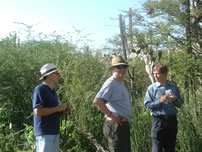 I
recently took part in one of the most interesting
expeditions I have made in Honduras. Being a
Board Member of the Pico Bonito National Park
Foundation I took the opportunity to walk through
the reserve on a recognizance expedition. The
Foundation aims to preserve this area which
encompasses one of our countries most important
natural treasures. The expedition was made up
mostly by technicians and a group from the ECOLOGIC
foundation which is implementing a series of
conservation programs in Central America. I
recently took part in one of the most interesting
expeditions I have made in Honduras. Being a
Board Member of the Pico Bonito National Park
Foundation I took the opportunity to walk through
the reserve on a recognizance expedition. The
Foundation aims to preserve this area which
encompasses one of our countries most important
natural treasures. The expedition was made up
mostly by technicians and a group from the ECOLOGIC
foundation which is implementing a series of
conservation programs in Central America.
The expedition aimed to cross
from south to north the “Nombre de Dios
Mountain Range”, beginning in the Department
(province) Of Yoro, across the 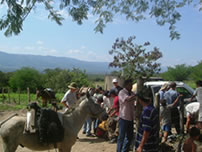 mountain
range to the Department of Atlantida, in the
north coast of Honduras close to La Ceiba. It
was a 2 day and a half walk in which the last
4 or 5 kilometers I did on horseback due to
a bad knee. mountain
range to the Department of Atlantida, in the
north coast of Honduras close to La Ceiba. It
was a 2 day and a half walk in which the last
4 or 5 kilometers I did on horseback due to
a bad knee.
We started with a visit to what is called The
“Dry Forest” in the southern side
side of Yoro, a forest with a very particular
flora. Many of the plants are endemic (only
found here). This is the habitat of the Emerald
Hummingbird, unique to Honduras.
It is because of its lack of protection that
a road is waiting to be paved in this part of
the country. The World Bank agreed to lend the
funds once the Hummingbirds environment was
protected.
So far our governments haven’t complied,
however there is now a growing interest to protect
its habitat.
The Emerald Hummingbird survives mainly from
a small red flower that grows from very fine
cacti.
Campesinos in the area call this delicate plant
“Pie de Niño” or child’s
foot. The cacti disappear once these forests
are used for feeding cattle, making it the
biggest threat for the bird’s survival.
We were also told that it is here that the very
rare combination of orchids living in cacti
occurs. Unfortunately I don’t have photographs
of a beautiful cluster of orchids that we saw
flowering amidst a cacti.
The Sad Yellow
Tree
According to the Biologist that kindly showed
us around, the yellow tree seen in this photograph
grows for about twenty years at the end of which
it flowers and then dies. I thought of it as
very moving and even worthy of a song.
Preparing To Leave
The expedition consisted of 10 of us. We used
horses to carry most of the gear. Some of the
members alternated between walking and horseback.
Here we are preparing to leave.
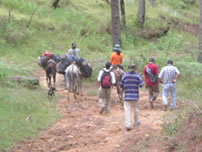 Going
Uphill Through Second Generation Pine Going
Uphill Through Second Generation Pine
The beginning of the expedition involved walking
uphill through roads that were originally made
by loggers who cut the entire first generation
of these pine trees without any control whatsoever.
The forest that you see in the photograph is
second generation. The way it has grown back
naturally gives us hope for they are now protected.
 Last
Rays Of The Sun Last
Rays Of The Sun
We walk up hill until the end of the day. I’ve
had very few physical challenges like hiking
up these mountains. At the end of this test,
however, I’m rewarded by the most beautiful
and peaceful view. The landscape in the picture
shows the last rays of light and the last hills
in which we see agricultural activity. Sadly
the night falls right before we must enter enter
the density of the tropical forest.
With “Ocote”
Torches Through The Dark Rainforest
One of our Guides brought
a few branches of “Ocote” selected
pine branches with a large amount of combustible
resin which is used in the countryside as torches.
This was one of the hardest parts of the trip.
Descending a mountain through the tropical forest
and at night is a critical combination and a
challenge to safety. Finally after a few hours
of mud, low visibility and anxiety, we arrived
to our first camp, a small hut beside the thatched
roof of a family that inhabits  these
mountains. I must say I didn’t expect
the low temperature we experienced at night.
Usually one does not associate freezing with
tropical forests. Despite being prepared for
what I thought could be a cold night, I wasn’t
able to sleep in my hammock due to the low temperature. these
mountains. I must say I didn’t expect
the low temperature we experienced at night.
Usually one does not associate freezing with
tropical forests. Despite being prepared for
what I thought could be a cold night, I wasn’t
able to sleep in my hammock due to the low temperature.
The Lush of Honduran
Rainforests
We walk through many unforgettable
trails and landscapes. Being that this was a
technical expedition there isn’t the time
I need for contemplating the beauty of it all.
Water, Water
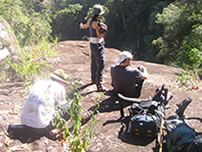 We
cross innumerable brooks and small waterfalls
before we arrive to where The Cangrejal River
begins. City dwellers have a hard time making
the connection Between the water they use everyday
and the preservation of the “sponges”
that our rainforests are. We
cross innumerable brooks and small waterfalls
before we arrive to where The Cangrejal River
begins. City dwellers have a hard time making
the connection Between the water they use everyday
and the preservation of the “sponges”
that our rainforests are.
View to Precede a Spectacular Waterfall
As we come to these rocks the sound of water
announces an amazing waterfall and the most
difficult part of our journey.
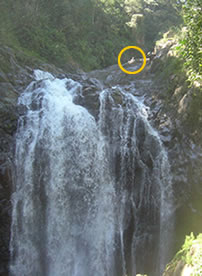 What
Very Few Eyes Have Seen What
Very Few Eyes Have Seen
We descend through a series
of very difficult and slippery paths to the
bottom of what is one of the most beautiful
waterfalls I have ever seen. This spectacle
is so hidden amidst these forests that one is
also sure that very few eyes have seen it.
On the top right side of the photo I placed
a small arrow which points at one of the members
of the expedition for you to see the size of
the fall. I must say this was the highlight
of the trip for me. It was spiritually moving
to be before this waterfall.
Last Day, Walking
Downriver (The Infinite Hues of Green)
I find myself very limited
in describing the trip with a few words and
pictures. I have done my best. I’m considering
doing this walk again with the hope of doing
a whole entry to this journal on the lives of
the people who live in these forests. I wish
I could share more closely my impressions of
the jungle, the smell of the vegetation the
sound of water. Not being able to sleep because
of trying to concentrate in the different tonalities
of the insects and birds that sing at night.
The size of the leaves. The infinite hues of
green, the colors of the birds and finally,
to feel the privilege and the spirituality of
being in one of the last natural treasures left
in the planet, more convinced than ever of the
importance to conserve it.
-Guillermo Anderson
Thanks:
Fundación Parque Nacional Pico Bonito
All Photos: Guillermo Anderson
For More Information Regarding Visiting or Helping
The Pico Bonito Natl. Park Foundation
Write to: Fundacion Pico Bonito E-mail : fupnapib@laceiba.com
|